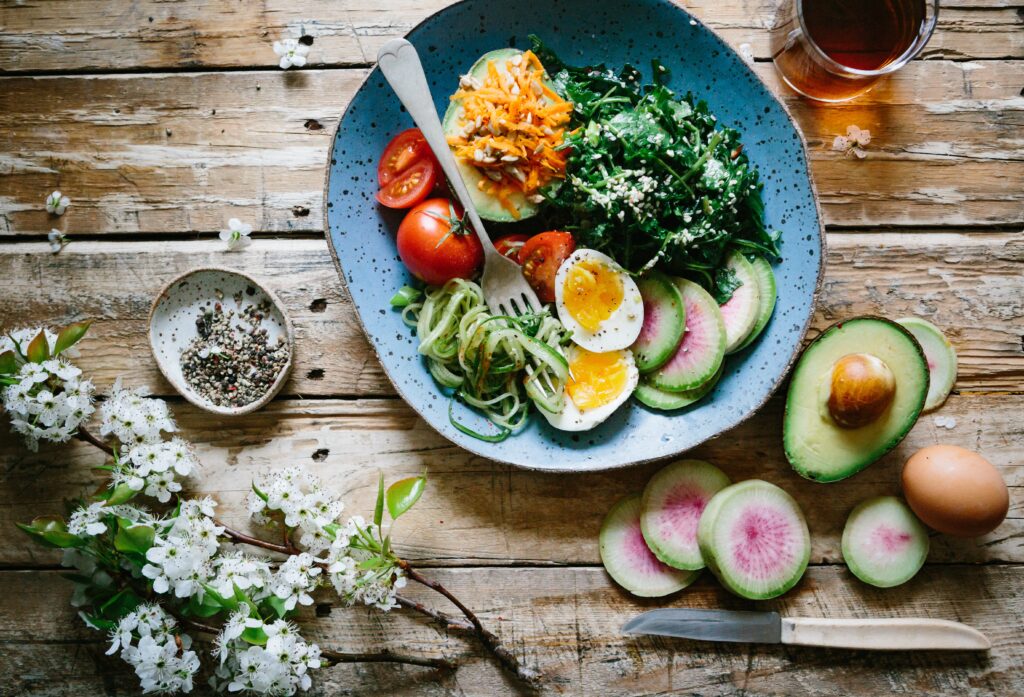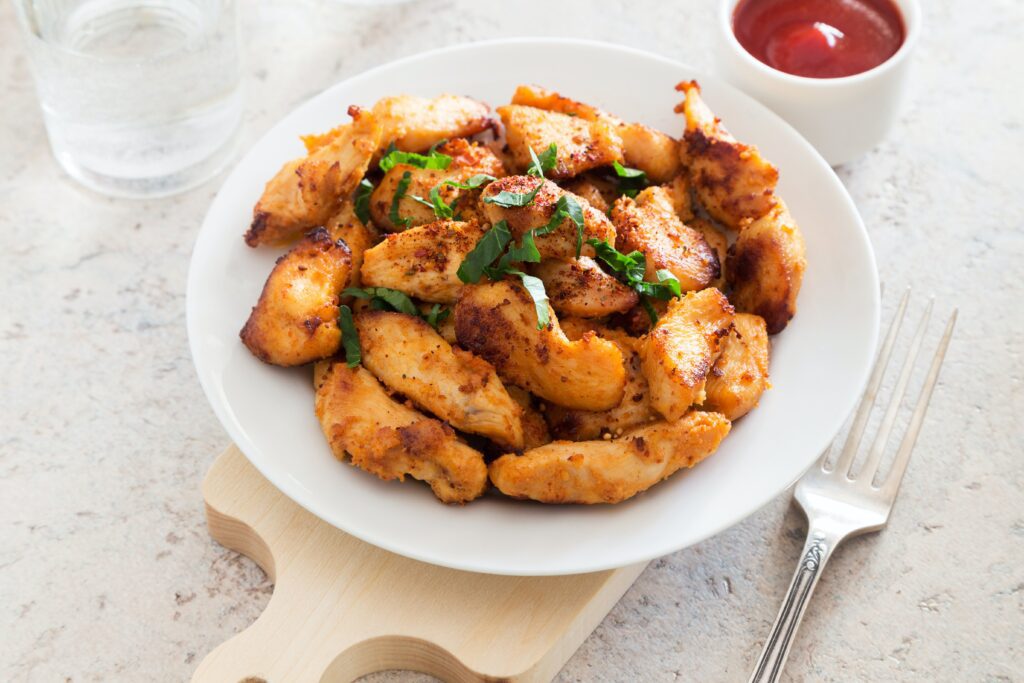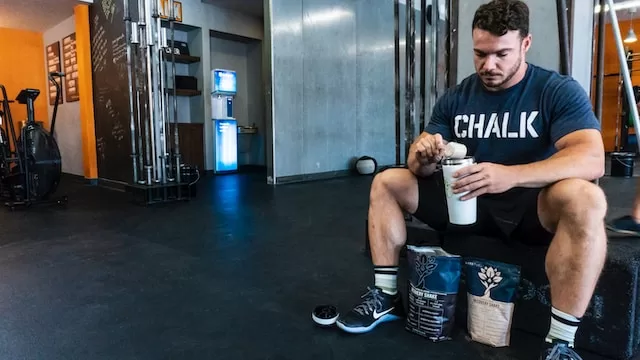Popular CrossFit Diets: What’s the Best Nutrition Plan?

Are you a Crossfit enthusiast looking to improve your performance? Look no further than your diet. Crossfit diets are specifically designed to support high-intensity training and promote clean eating, focusing on whole foods and avoiding processed options. The primal approach is a popular way that many Crossfitters structure their diets, but there are various other methods used as well, such as iifym. It is important to monitor your fat intake and caloric intake to ensure optimal results.
Research suggests that a well-planned Crossfit diet, including iifym and clean eating, can not only improve energy levels but also enhance overall performance during workouts. Many athletes track their macros and time their nutrient intake to ensure they’re getting enough carbs and supplements for optimal results. So what are the best crossfit diets, and which ones do crossfitters follow? But first, let’s dive into why nutrition is so critical for success in Crossfit training.
Benefits of a CrossFit Diet Plan
CrossFit is a popular fitness program among crossfitters that focuses on functional movements, high-intensity workouts, and varied exercises. In addition to physical training, CrossFit also emphasizes nutrition as an essential component of overall health and fitness. A CrossFit diet plan, designed for strength athletes, is aimed at providing balanced nutrition for optimal athletic performance and fat loss through iifym and clean eating.
Fat Loss
One of the primary benefits of a CrossFit diet plan for crossfitters is weight loss. The program emphasizes eating whole foods that are nutrient-dense and low in calories, which is also compatible with the iifym approach. By consuming these foods, individuals can reduce their caloric intake while still meeting their nutritional needs. The high-intensity exercises associated with CrossFit, combined with intense exercise, can increase metabolism and burn more calories throughout the day. In addition, taking supplements can also support the body’s nutritional requirements.
A CrossFit diet plan typically includes protein-rich foods such as lean meats, eggs, and fish that are favored by crossfitters; complex carbohydrates like fruits, vegetables, and whole grains which are great for clean eating; healthy fats from sources like nuts, seeds, avocadoes which are also suitable for iifym (if it fits your macros); and limited amounts of processed foods or added sugars to help manage carbs intake.
Improved Athletic Performance
Another benefit of following a CrossFit diet plan is improved athletic performance for crossfitters. Consuming whole foods through clean eating that are rich in nutrients can help crossfitters perform better during workouts by providing them with the energy they need to push through intense exercises while reducing fat intake for fat loss.
Consuming adequate amounts of protein and carbs can help build muscle mass and provide energy during prolonged exercise sessions, making it essential for crossfit nutrition. A well-balanced crossfitters diet should also include healthy fats to aid in fat loss, improve strength, and power output during high-intensity workouts.
Balanced Nutrition for Overall Health
A third benefit of following a CrossFit diet plan for crossfitters is balanced nutrition for overall health and fat loss during workout. The program emphasizes consuming whole foods that are rich in vitamins, minerals, fiber, and complex carbs while limiting processed foods or added sugars which may contribute to chronic diseases like diabetes or heart disease.
By regularly consuming nutrient-dense foods as part of a primal diet, individuals can improve their overall health by reducing inflammation levels, improving gut health, and supporting their immune system. This approach to crossfit nutrition is also beneficial for those looking to achieve fat loss goals while following the zone diet.
Meal Planning and Preparation
Finally, the structure of a CrossFit diet plan can help crossfitters with meal planning and preparation before and after an intense workout. The program emphasizes consuming whole foods that are easy to prepare like roasted vegetables, grilled meats or fish, and salads, which can help reduce fat after intense exercise. By focusing on these types of foods individuals can save time in the kitchen while still meeting their nutritional needs.
Many CrossFit diet plans provide weekly meal plans or grocery lists which can make shopping for food more manageable for crossfitters who engage in intense exercise workouts and want to reduce fat.

Popular CrossFit Diets for Athletes: The Zone Diet, IIFYM Diet, Paleo Diet, and Ketogenic Diet
CrossFit athletes, or crossfitters, require a diet that provides them with enough energy to fuel their intense exercise while also ensuring that they maintain a healthy weight. With so many diets out there, it can be challenging to know which one is right for you and ensures that you consume enough fat and carbs to support your body during workouts.
The Zone Diet
The Zone diet, popular among crossfitters, was created by Dr. Barry Sears and focuses on balancing macronutrients through zone blocks. A single block consists of 9 grams of carbohydrates, 7 grams of protein, and 1.5 grams of fat, making it a great option for crossfit nutrition. The goal is to eat meals that consist of a certain number of blocks depending on your body size and activity level, helping you fuel your workout with the right amount of carbs.
The Zone diet has been popular among CrossFit athletes, or crossfitters, because it allows them to control their insulin levels by keeping their macronutrient ratios in check. This helps prevent energy crashes during intense exercise and keeps them feeling full throughout the day. Additionally, the diet also helps manage the intake of fat and carbs, making it a well-rounded option for those looking to optimize their athletic performance.
The IIFYM (If It Fits Your Macros) Diet
The IIFYM diet, also known as Crossfit nutrition, emphasizes flexibility in food choices to meet daily macronutrient levels. This means that you can eat anything you want, including foods high in fat and carbs, as long as they fit into your daily calorie and macronutrient goals. This approach allows for optimal fueling before and after a workout, making it a popular choice among those who prioritize their fitness goals.
This diet has gained popularity among CrossFit athletes because it allows them to enjoy their favorite foods while still getting the nutrients they need to perform at their best during intense exercise workouts. Additionally, the diet includes enough carbs to sustain their energy levels at all times.
The Paleo Diet
The Paleo diet, popular among CrossFit enthusiasts, emphasizes whole foods and eliminates processed foods from your diet entirely. This includes grains, legumes, dairy products, refined sugar, and processed oils. By reducing carbs and focusing on clean eating, it can help improve your workout performance week after week.
Many CrossFit athletes have found success with the Paleo diet because it provides them with nutrient-dense foods that fuel their workouts while also promoting overall health. The diet is also compatible with the Zone method, which helps athletes balance their intake of carbs and other nutrients.
The Ketogenic Diet
The Ketogenic diet can put you in the zone during your workout, as it is high in fat and low in carbs. This type of diet leads to improved energy levels for athletes by inducing a state of ketosis where the body burns fat for fuel instead of glucose.
CrossFit athletes who follow the ketogenic diet and restrict their carb intake have reported increased endurance during workouts and faster recovery times between sessions. Some athletes also follow the zone diet, which involves carefully balancing their intake of carbs, protein, and fat to optimize performance.
Sample Menu for a CrossFit Diet Plan
If you’re looking to improve your performance in CrossFit, nutrition is key. A well-balanced diet in the zone can help you build muscle, increase endurance, and recover faster from workouts. But what exactly should you be eating? Here’s a sample menu for a CrossFit diet plan in the zone that will give you an idea of what types of foods to include in your daily meals.
High Protein Meals
Protein is essential for building and repairing muscle tissue, which is why it’s such an important part of a CrossFit diet plan in the zone. Here are some examples of high protein meals you might include in your daily menu for the zone:
- Grilled chicken breast with roasted vegetables
- Salmon fillet with quinoa salad
- Lean ground beef stir-fry with broccoli and brown rice, perfect for CrossFitters diet, Primal diet, and Zone diet enthusiasts.
These meals all contain at least 20 grams of protein per serving, which is the minimum amount recommended for athletes who are following a crossfitters diet, primal diet, or zone diet and trying to build muscle mass.
Typical Lunch Options
Lunchtime can be challenging when you’re trying to stick to a healthy diet in the CrossFit zone. Many people opt for quick and easy options like fast food or frozen meals, but these choices are often high in calories and low in nutrients. Here’s an example of a typical lunch option on a CrossFit diet plan within the zone:
- Grilled chicken breast with mixed greens salad
- Roasted sweet potato wedges
- Balsamic vinaigrette dressing on the side
This meal is perfect for those following the zone diet, providing plenty of protein to fuel your muscles and complex carbohydrates from sweet potatoes to keep you feeling full throughout the afternoon.
Snacks To Keep You Going
When hunger strikes in the zone between meals, it’s important to have healthy snack options on hand. Here are some simple ideas that won’t derail your diet in the zone:
- Small handful of almonds or cashews
- Apple slices with almond butter
- Hard-boiled egg with carrot sticks
These snacks all provide a small amount of protein and healthy fats to keep you satisfied until your next meal on the zone diet.
Example Meal Plan
Putting together a meal plan can be daunting, but here’s an example of what a day on a CrossFit diet might look like:
- Breakfast: Omelet with spinach, mushrooms, and feta cheese
- Snack: Small handful of trail mix (nuts, seeds, and dried fruit) suitable for Zone Diet.
- Lunch: Grilled chicken breast with mixed greens salad and roasted sweet potato wedges, perfect for the Zone diet.
- Snack: Apple slices with almond butter
- Dinner: Salmon fillet with quinoa salad and roasted asparagus
This meal plan, following the zone diet, provides plenty of protein to fuel your workouts, as well as complex carbohydrates from the vegetables and whole grains. It also includes healthy fats from nuts and seeds to support overall health.

Best Foods for CrossFitters: Lean Proteins, Complex Carbohydrates, Healthy Fats, and Vegetables
CrossFit is a high-intensity fitness program that requires a lot of energy and effort. To support this level of training and recovery, CrossFitters must consume the right foods in the right amounts while following the zone diet.
Macronutrients: The Building Blocks of Nutrition
Before we dive into specific foods, let’s talk about macronutrients. Macronutrients are the three main components of our diet: protein, carbohydrates, and fat. Each macronutrient plays a critical role in fueling our bodies during exercise and recovery.
Lean Proteins
Protein is essential for muscle growth and repair, especially on a zone diet. CrossFitters should aim to consume 1-1.5 grams of protein per pound of bodyweight daily. Some great sources of lean protein include:
- Chicken breast
- Turkey breast
- Fish (salmon, tilapia)
- Lean beef (round steak, sirloin)
- Eggs
- Greek yogurt
- Cottage cheese
If you follow the zone diet and struggle to meet your daily protein needs through whole foods alone, consider using supplements like whey protein powder or BCAAs.
Complex Carbohydrates
Carbohydrates provide energy to fuel our workouts and help with recovery afterward. For strength athletes like CrossFitters who follow the Zone Diet, complex carbohydrates are an excellent choice as they provide sustained energy throughout the day. Good sources of complex carbs include:
- Whole grains (brown rice, quinoa)
- Starchy vegetables (sweet potatoes, butternut squash)
- Legumes (lentils, chickpeas)
- Fruit (apples, berries)
While some people may recommend avoiding carbs altogether when trying to lose weight or build muscle mass quickly, following the zone diet can be a more sustainable long-term approach for most people.
Healthy Fats
Healthy fats are an essential part of a well-rounded diet. They help with hormone production, brain function, and energy levels. Some great sources of healthy fats include:
- Avocado
- Nuts (almonds, walnuts)
- Seeds (chia seeds, flaxseeds)
- Olive oil
- Coconut oil
- Fatty fish (salmon, sardines)
Vegetables
Vegetables are packed with vitamins, minerals, and fiber that support overall health and wellbeing. Eating a variety of colorful vegetables can help ensure you’re getting all the nutrients your body needs on the zone diet. Some great veggies for CrossFitters on the zone diet include:
- Broccoli
- Spinach
- Kale
- Bell peppers
- Carrots
Putting it All Together: Meal Ideas for CrossFitters
Now that we’ve covered the basics, let’s look at some meal ideas that incorporate these foods while following the zone diet.
Breakfast
Eggs with spinach and bell peppers; whole-grain toast with avocado spread, perfect for the Zone diet.
Greek yogurt with berries, chia seeds, and nuts on top, perfect for the zone diet.
Lunch
Grilled chicken breast; roasted sweet potatoes; steamed broccoli.
Lentil soup;
Worst Foods for CrossFitters: Processed Foods, Sugary Drinks, Alcohol, and Trans Fats
Nutrition plays a crucial role. While there are many popular diets that CrossFitters follow, it’s essential to know what foods to avoid.
Processed Foods
Processed foods are one of the worst things you can eat as a CrossFitter on the zone diet. These foods are typically high in calories and low in nutritional value. They also contain unhealthy additives like salt, sugar, and trans fats that can lead to weight gain and other health problems.
Instead of processed foods, opt for whole foods like fresh fruits and vegetables, lean proteins like chicken or fish, nuts and seeds, and complex carbohydrates like sweet potatoes or brown rice. These nutrient-dense options will provide your body with the fuel it needs to perform at its best while following the zone diet.
Sugary Drinks
Sugary drinks like soda or sports drinks should be avoided by CrossFitters who follow the Zone Diet due to their negative impact on blood sugar levels. Drinking these beverages can cause blood sugar spikes followed by crashes which can lead to decreased glycogen stores and inflammation.
Instead of sugary drinks, try drinking water or unsweetened tea during your workouts. If you follow the Zone Diet, consider natural sources such as caffeine from coffee or green tea for an energy boost during long workouts or competitions.
Alcohol
While alcohol may seem like a good way to unwind after a tough workout or competition, it’s important to remember that alcohol is not beneficial for recovery purposes. Alcohol consumption elevates heart rate activity which interferes with muscle repair processes leading to slower recovery times.
Additionally alcohol blocks absorption of dietary fat which means that if you consume alcohol with fatty food you will absorb fewer nutrients than if you consumed them separately.
If you choose to drink alcohol, do so in moderation and avoid drinking after your workouts. Instead, opt for water or a protein shake to help your body recover.
Trans Fats
Trans fats are another food that CrossFitters should avoid. These fats have been linked to an increased risk of heart disease, type 2 diabetes, and other health problems. They’re commonly found in fried foods like french fries or donuts as well as packaged snack foods like cookies and crackers.
Instead of trans fats, choose healthy fats such as those found in nuts and seeds, avocados, olive oil, fatty fish like salmon or mackerel.

Importance of Proper Nutrition for CrossFit Performance
Nutrition is vital for optimal CrossFit performance. It is the foundation of a healthy lifestyle and can make or break your progress in the gym. Proper nutrition supports muscle growth, body composition, energy levels, and recovery.
Macronutrient Intake Plays a Crucial Role in Muscle Growth and Body Composition
Macronutrients are essential nutrients that provide calories or energy to the body. These include carbohydrates, protein, and fat. Each macronutrient plays a crucial role in muscle growth and body composition.
Carbohydrates are the primary fuel source for high-intensity exercise like CrossFit. They provide glucose to your muscles, which they use as energy during workouts. Without enough carbohydrates, you may feel sluggish during training sessions.
Protein is crucial for muscle growth and repair. When you do intense exercise like CrossFit, you create tiny tears in your muscles. Protein helps repair these tears and build new muscle tissue.
Fat is also important for overall health but has a more indirect effect on performance. It provides insulation to keep your body warm during cold weather training sessions and acts as an energy reserve when carbohydrate stores run low.
Nutritional Needs Vary Based on Exercise Intensity, Physical Job Demands, and Heart Rate
The nutritional needs of each individual vary based on their intensity of exercise, physical job demands, heart rate variability (HRV), age, sex etc., but it’s essential to ensure adequate intake of all three macronutrients to support optimal performance.
For example:
- A CrossFitter who trains five days per week at high intensity will require more carbohydrates than someone who only trains twice per week.
- Someone with a physically demanding job may need more protein than someone with a sedentary job.
- HRV can affect how much you need to eat before or after workouts.
- Age and sex can also play a role in determining nutritional needs.
Adequate Nutrition is Necessary for Recovery, Strength, Energy, and to Minimize the Interference Effect on Performance
Adequate nutrition is necessary for recovery after intense exercise. It helps repair muscle tissue damage and replenish glycogen stores in the body. Without proper nutrition, you may feel fatigued and unable to perform at your best.
Nutrition also plays a crucial role in strength development. Protein intake is essential for building new muscle tissue while carbohydrates provide energy for high-intensity workouts that build strength.
Energy levels are also affected by nutrition. Carbohydrates provide glucose to your muscles, which they use as energy during workouts. Without enough carbohydrates, you may feel sluggish during training sessions.
Finally, inadequate nutrition can lead to the interference effect on performance. The interference effect occurs when two types of training have conflicting adaptations in the body. For example, if you do too much cardio without adequate protein intake, it can interfere with your ability to build muscle mass.
Choosing the Right Diet for Your CrossFit Journey
In conclusion, choosing the right diet is crucial for your CrossFit journey. The benefits of a CrossFit diet plan include increased energy levels, improved performance, and better recovery. The top diets for CrossFit athletes are the Zone Diet, IIFYM Diet, Paleo Diet, and Ketogenic Diet. These diets focus on lean proteins, complex carbohydrates, healthy fats, and vegetables while avoiding processed foods, sugary drinks, alcohol and trans fats. Proper nutrition is essential to achieve optimal performance in CrossFit workouts.
To optimize your nutrition intake for your next workout session:
- Choose a diet that aligns with your fitness goals.
- Incorporate lean proteins such as chicken breast or fish into your meals.
- Avoid processed foods and sugary drinks.
- Eat complex carbs like quinoa or brown rice to fuel your body.
- Stay hydrated by drinking plenty of water throughout the day.
By following these tips and staying consistent with your diet plan, you will see significant improvements in your overall health and fitness level.
FAQs
1. What should I eat before a CrossFit workout?
It’s best to eat a meal containing complex carbohydrates and protein about 2-3 hours before a workout. This could be something like grilled chicken with sweet potatoes or brown rice.
2. Can I still enjoy cheat meals while on a crossfit diet plan?
Yes! It’s okay to indulge in moderation occasionally. Just make sure not to overdo it and get back on track with your regular healthy eating habits after.
3. How much protein do I need as a crossfit athlete?
Aim to consume around 1 gram of protein per pound of bodyweight each day to support muscle growth and recovery.
4. Is it necessary to count calories on a crossfit diet plan?
While counting calories isn’t necessary for everyone, it can be helpful to ensure you are consuming enough nutrients and not overeating. However, it’s important to focus on the quality of the food you’re eating rather than solely on calorie intake.
5. Can I follow a vegetarian or vegan diet while doing CrossFit?
Absolutely! There are plenty of plant-based protein sources such as tofu, lentils, and tempeh that can be incorporated into your meals to support your fitness goals.

Dave Carter
Dave serves as the head writer and chief content curator for CrossFitopedia.com, the premier destination for CrossFit enthusiasts seeking to enhance their fitness journeys.

